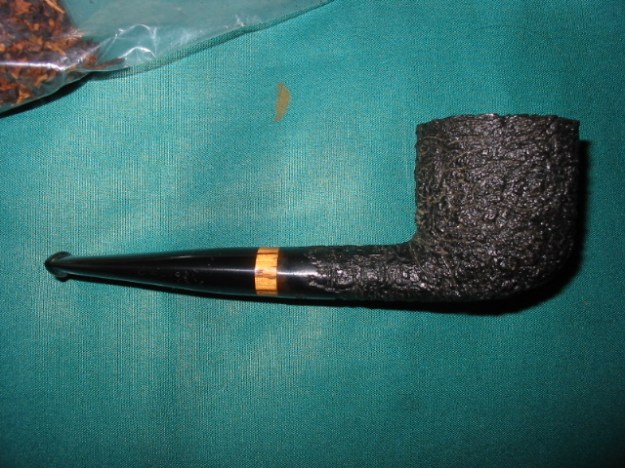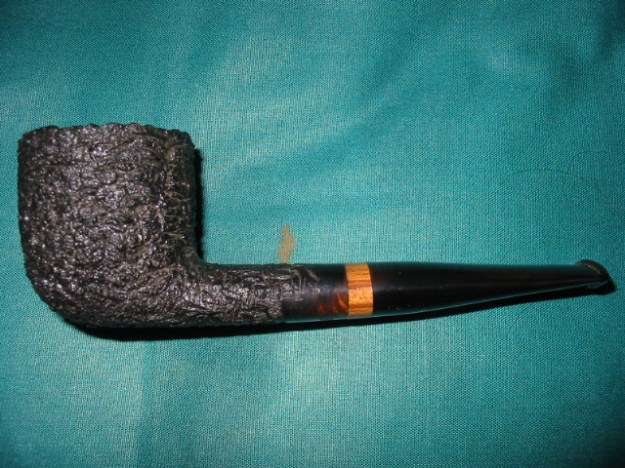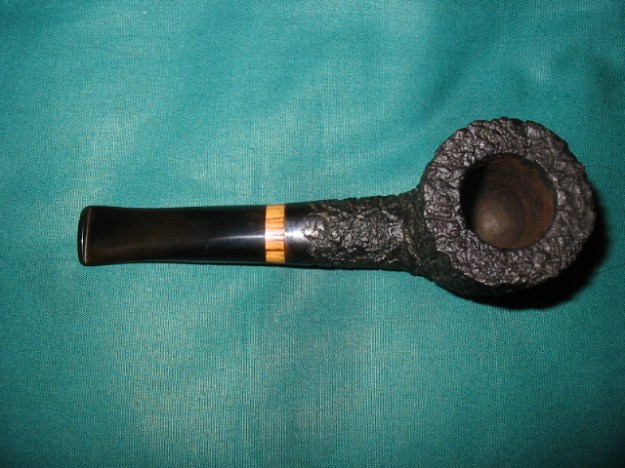Blog by Steve Laug
I was drawn to this little rusticated estate pot when I saw in on Keith/Exile’s estate pipe site, http://exilesplace.dk/. I had not heard of Benner before so it was not the name that drew me but rather the look of the pipe that called out to me. Keith sells Benner’s pipe new as well, but in looking at them I still wanted this one. I emailed Keith and soon the pipe was on its way to me from Denmark.

While I was waiting for it to arrive I did some research on who Benner was in terms of the realm of Danish pipe carvers. Keith had this information:
“His real name is Bent Nielsen but the world knows him as Benner. Benner has been making pipes for a long time. He once worked with the late and great Karl Erik Ottendahl and did some design work for Stanwell at one time. He has exported to the US, Germany and, lately, to Russia. These days Benner runs his workshop as the mood takes him and he says he is looking forward to retirement. If I know Benner, that retirement won’t be a permanent thing.” http://thepipesmoker.wordpress.com/2011/04/10/benner/
I found this picture of Benner on the web and also found information on Pipedia http://www.pipedia.org/wiki/Benner

“Considering his reputation among some connoisseurs Bent Nielsen, nicknamed Benner, didn’t leave too much usable traces. He is sometimes mentioned as a nephew of Viggo Nielsen, but in fact he’s no relative of Viggo’s clan.
Starting around 1970 he worked for Karl Erik some years and later for Stanwell, where he sketched a number of new models. Around the climax of enthusiasm for Danish freehands he started to release pipes under his own name. Not too many at all, which stuck more closely to classical models.
He later worked under the synonym Benner. His German distributor however advised him against using his nickname for sales in Germany, because Benner didn’t sound really Danish. Benner, as a Danish pipester recently told, “dared” to carve some more fancy styled pipes than Bent Nielsen did before and every now and then he made some pipes of olive wood, too.
Still he’s supposed to make a few pipes every once in a while selling them to a few local shops in Denmark and a limited number of enthusiasts all over the world.”
I don’t remember the exact date when I purchased my Benner pot from Keith but I have been a frequent visitor to his website and his blog for a long time now. I frequently scan through his listings to see if anything in particular catches my eye. The particular day I found the Benner listed I am not sure what captured me – the shape, the gentle taper of the sides of the oval shank, the rugged rustication, the walnut band. I am just not sure. I am typically not attracted to pot shaped pipes. I have a few in my collection but they are minimal and I am rarely drawn to them when I reach for a pipe. But I remember seeing this one and being captured by it. I left the site, went to work and later that evening I bought the pipe.
The pipe is small, almost a nosewarmer at 4 3/4 inches long and 1 ½ inches tall. The tobacco chamber is 1 1/8 inches deep and 3/4 inches in diameter. The band is smooth, naturally finished hardwood (walnut or oak?) and adds a contrast to the dark stained rustication. It is integrated into the stem. The stem is handmade from vulcanite and has a gentle taper.
 When the pipe arrived it was far more impressive than Keith’s pictures had led me to expect. The workmanship of the pipe and colour and feel of it in my hand just captured me. I remember opening the package and sliding the pipe out of the sleeve and enjoying the look and feel of this pipe. It was and is beautiful. It had the faint aromas of the Virginias that its previous owner had smoked, yet it was clean and ready for me. The rustication is tactile yet is not sharp or jarring. It is a tight pattern that almost looks like it was sandblasted after rusticating. Examining it up close it is obvious that it is not blasted but that a master-hand rusticated it very well. The bowl is rusticated up and over the rim and ends at the inner rim edge. There is a smooth band of briar at the shank end that is narrow on the top and sides of the oval shank and slightly wider on the bottom of the shank to provide a spot for the stamping. The overall flow of the bowl and shank is brilliant and the colours are beautifully matched from rim to the end of the shank with a contrast of black stain and the underlying colour of the briar. Combined with the black of the vulcanite it gives the pipe a dressy look. The natural wood band that is part of the stem that not only separates the texture of the bowl and stem but gives focal point that draws the eye to take in the taper of the stem and the texture of the bowl.
When the pipe arrived it was far more impressive than Keith’s pictures had led me to expect. The workmanship of the pipe and colour and feel of it in my hand just captured me. I remember opening the package and sliding the pipe out of the sleeve and enjoying the look and feel of this pipe. It was and is beautiful. It had the faint aromas of the Virginias that its previous owner had smoked, yet it was clean and ready for me. The rustication is tactile yet is not sharp or jarring. It is a tight pattern that almost looks like it was sandblasted after rusticating. Examining it up close it is obvious that it is not blasted but that a master-hand rusticated it very well. The bowl is rusticated up and over the rim and ends at the inner rim edge. There is a smooth band of briar at the shank end that is narrow on the top and sides of the oval shank and slightly wider on the bottom of the shank to provide a spot for the stamping. The overall flow of the bowl and shank is brilliant and the colours are beautifully matched from rim to the end of the shank with a contrast of black stain and the underlying colour of the briar. Combined with the black of the vulcanite it gives the pipe a dressy look. The natural wood band that is part of the stem that not only separates the texture of the bowl and stem but gives focal point that draws the eye to take in the taper of the stem and the texture of the bowl.

The inner mechanics of the pipe are perfect. The drilling is perfectly executed from the shank and into the bowl – coming out exactly centre in the bottom of the bowl. The airway from the bowl into the mortise is centred. It is smooth in its entrance to the mortise and the mortise itself is also smooth with no rough spot left by drill bit. The bowl itself is U-shaped and smooth from sides to bottom. The air way enters the bowl and is smooth and clean. As the pipe was an estate when it came to me it was impossible to tell if it originally had a bowl coating but my guess would be that it would have been smoothly sanded briar.
The stem itself is hand cut out of a vulcanite. It is well tapered with good even angles top and bottom progressing from the shank to the button. The portion of the stem that is put in the mouth is thin and comfortable. Benner did a great job shaping the stem and capturing a shape that really works with this pipe. The hardwood band is integral to the stem and is seamless in its flow with the vulcanite. The tenon is Delrin that has been inserted into the vulcanite stem for durability and ease of use. The airway is funnelled slightly for a smooth transition from the mortise when it is in place. There is a very minimal gap between the end of the tenon and the base of the mortise. The transition where the Delrin meets the vulcanite of the stem is seamless. There is no lip or rough spot at that junction. The draught is unrestricted and open from the bowl to the tip of the stem. Draught is effortless. The fit of the stem to the tenon is very well done. The button is cut to my liking with a good sharp inner edge and tapered to the tip. The slot is opened and funneled to deliver a uniform airway from bowl to button.

The overall construction of this pipe is very well done. It is light in the hand and in the mouth. It is well balanced and has a great tactile feel when it is cool and as it warms up during the smoking of a bowl. I have smoked the pipe since I got it and enjoyed the fact that it was previously smoked and well broken in. The shape of the bowl has kept this a good Virginia smoking pipe in my rotation. It delivered a good smoke from the first smoke and continues to do so. It draws well; the lighting has never been a problem and continues to be an effortless smoke. Thanks Keith for introducing me to this maker and to Benner for delivering a well-made pipe that remains a very good smoking pipe to this day. If you can acquire a pipe made by Benner (they are hard to come by as he makes just a few) it will not disappoint you and soon become a favourite in your rack.
